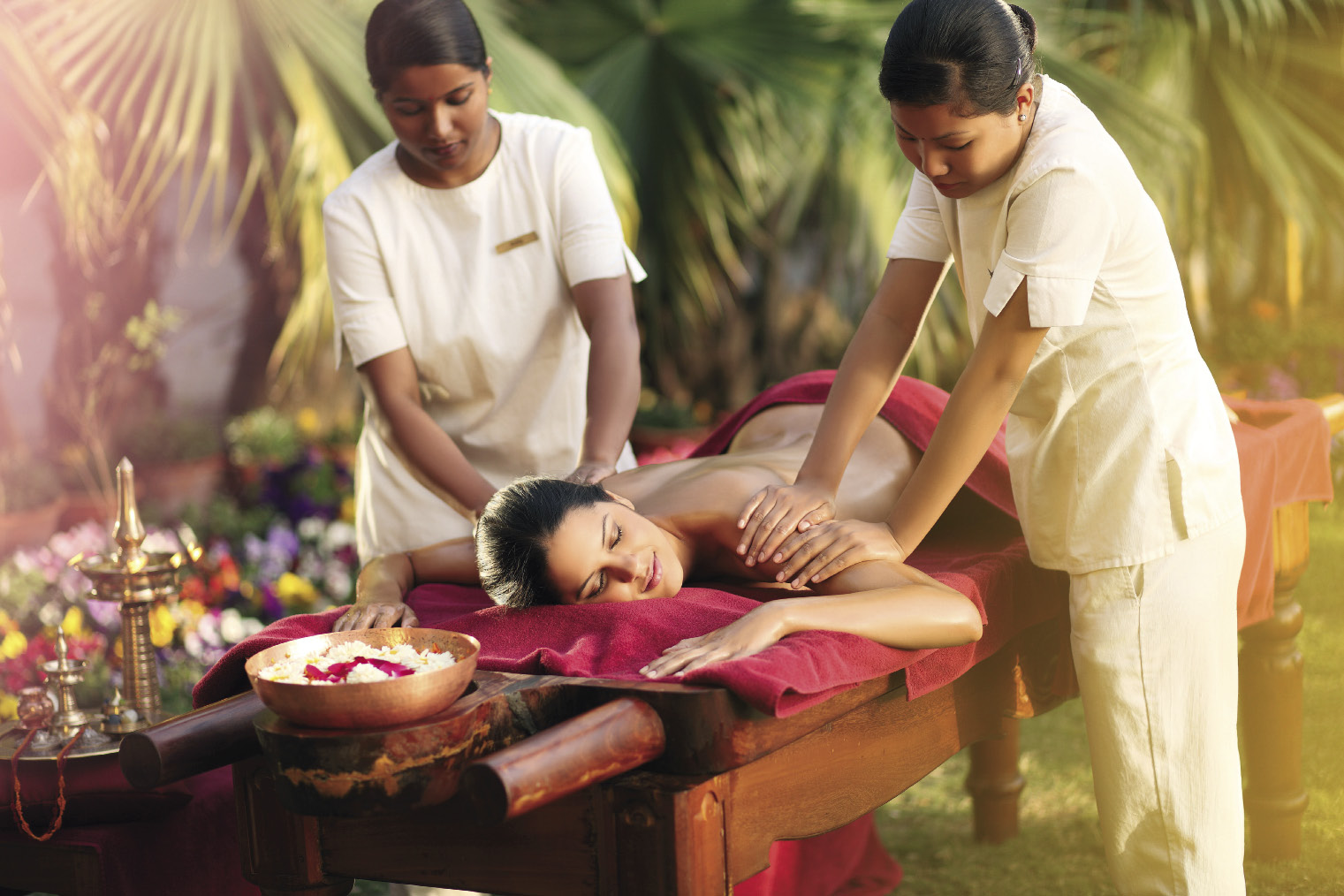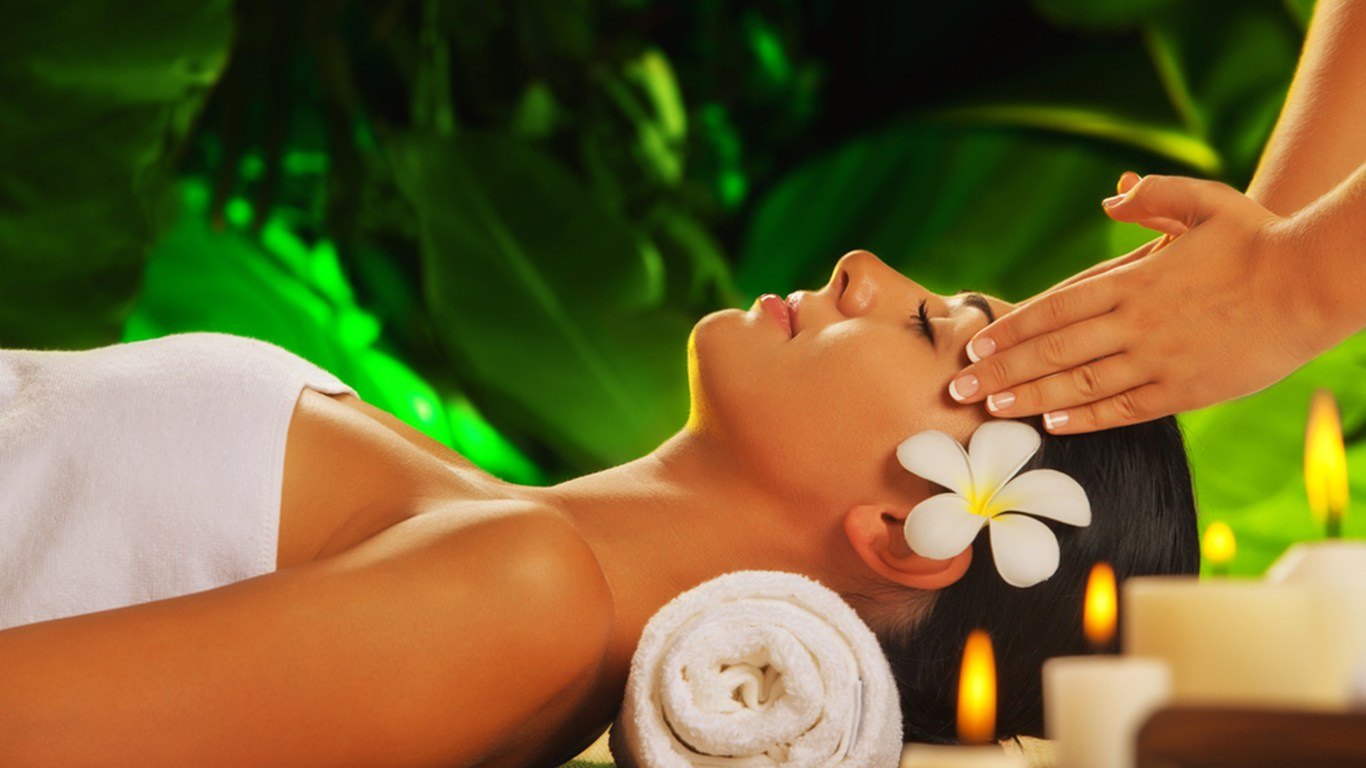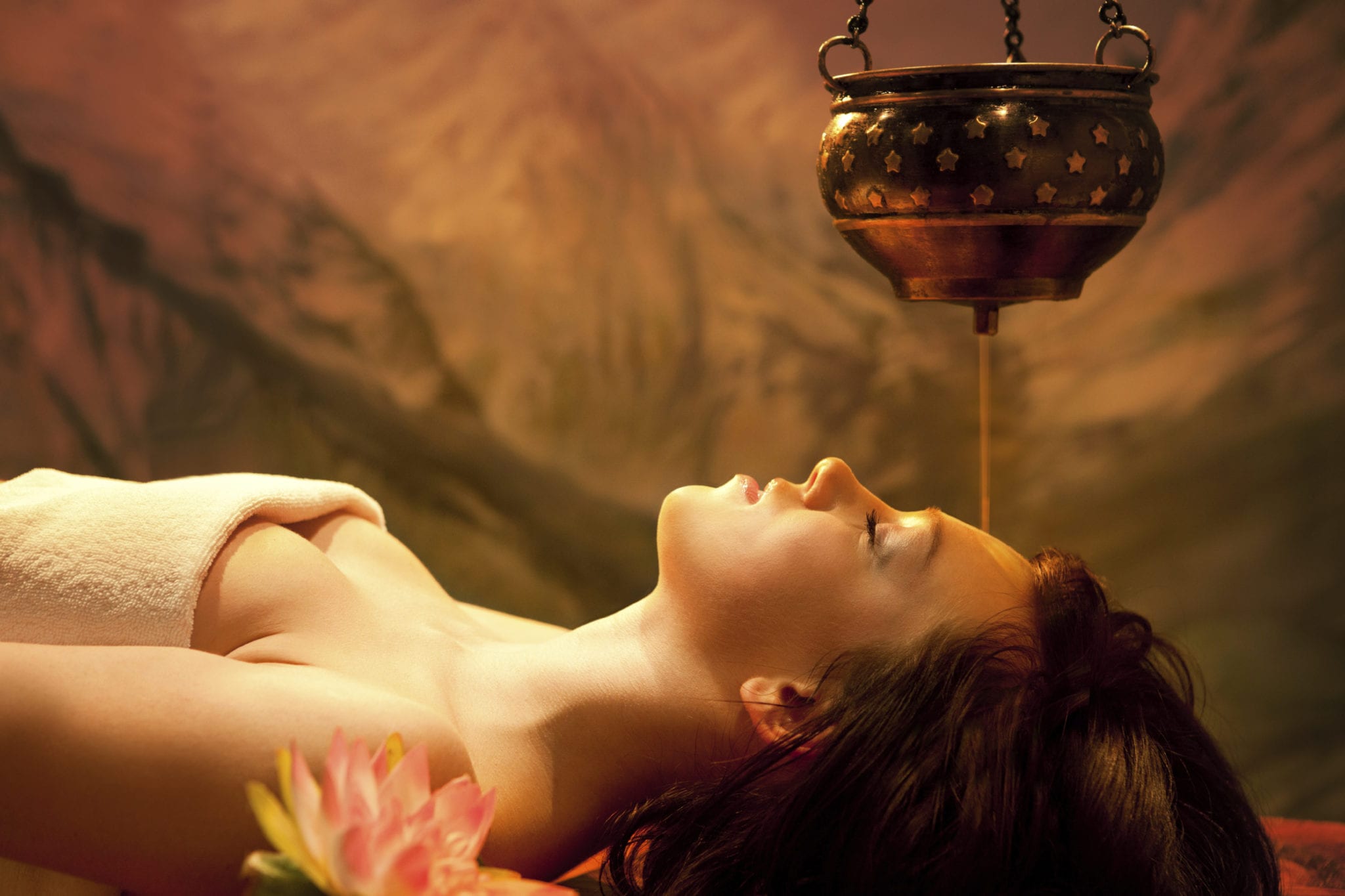 Ayurvedic Massage Kerala, India
Ayurvedic Massage Kerala, India

Kerala regionally also Keralam, is a state located in the south-west region of India on the Malabar coast. It was formed on 1 November 1956 per the States Reorganisation Act by combining various Malayalam-speaking regions. It is bordered by Karnataka to the north and north east, Tamil Nadu to the east and south, and the Laccadive Sea to the west. Thiruvananthapuram is the state capital among the 14 districts; other major cities include Kochi, Kozhikode, Kollam and Thrissur.
With the Arabian Sea in the west, the Western Ghats towering 500-2700 m in the east and networked by 44 rivers, Kerala enjoys unique geographical features that have made it one of the most sought after tourist destinations in Asia. An equable climate. A long shoreline with serene beaches. Tranquil stretches of emerald backwaters. Lush hill stations and exotic wildlife. Waterfalls. Sprawling plantations and paddy fields. Ayurvedic health holidays. Enchanting art forms. Magical festivals. Historic and cultural monuments. An exotic cuisine… All of which offer you a unique experience. And what’s more, each of these charming destinations is only a two hour drive from the other. A singular advantage no other destination offers. Kerala, India’s most advanced society: With hundred percent literacy. World-class health care systems. India’s lowest infant mortality and highest life expectancy rates. The highest physical quality of life in India. Peaceful and pristine, Kerala is also India’s cleanest state. For administrative purpose, the state of Kerala is divided into fourteen districts. Most of these districts offer all the tourism products typical of the State.
Kerala Ayurveda which originated some 5000 years ago in India, is regarded as the oldest healthcare system in the world, and is recognized as an esoteric and great science of wellness and longevity. A variety of ayurvedic rejuvenation massages, the ayurveda panchkarma, and miraculous ayurveda beauty therapy, etc., are now exclusively popular and preferred in all across India and numerous countries abroad. Moreover, there are several ailments and diseases which are not elegantly and completely treated by the modern medicines or treatment techniques, such as the lumbago, arthritis, frozen shoulder, spondylitis, slip disc, sciatica, sinusitis, stress and strain, depression, etc. These ailments are naturally and easily cured by kerala ayurveda.
The growth of Ayurveda and Ayurvedic treatment as a major attraction of Kerala Tourism brought a substantial increase in the number of Ayurveda treatment centers and Ayurveda Massage centers in Kerala. Many of these new born Ayurveda treatment and Ayurveda Massage centers lacked expertise and qualified technical personnel who could deliver quality Ayurvedic treatment as expected by the tourists and other people looking for Ayurveda treatment.
Ayurveda is the most ancient and traditional science, whose basic principles deal with the natural way of living a healthy life. In Ayurveda, health is defined as a state in which the structure and function of a particular individual is working optimally and the individual is in a state of physical, mental and spiritual equilibrium.
Ayurveda is based on certain theories like Panchamahabhutha theory and Tridosha theory. Ayurveda believes that everything in this universe is made up of five basic elements. These five elements are earth , water , fire , air and ether or space and collectively they are termed as Panchmahabhuta. Ayurveda believes that every living creature in the universe is made up of the five elements, which serve as the building blocks of life. Life doesn’t exist without these five elements . The permutation and combination of these elements and its quantity in a given matter determines its properties. Tridoshas Vata, Pitta, and Kapha are biological derivatives of the five basic elements present in the Universe.
At the time of conception, permutations and combinations of Vata, pitta and kapha determine the constitution of the new individual. These three metabolic forces govern all biological, psychological and physiological functions of the body, mind and consciousness and have subtle properties. Vata Dosha is responsible for movement, Pitta Dosha is responsible for transformation and lubrication is provided by Kapha Dosha. Kapha Dosha also binds two things together.The nervous system functioning by modern physiology for example, can be identified with Vata. The chemical process being carried out in the human body can be attributed to Pitta, including enzymes, hormones and the complete nutritional functioning and the activities of the skeletal and the anabolic system, actually the whole physical volume of an organism and all body fluids, can be identified with Kapha.
Vata, Pitta & Kapha are considered in Ayurveda to be the representative of Air, Sun and Moon respectively in the body. Their function is similar to that of Air, Sun and Moon in nature. Moon and its representative Kapha performs the function of nurturing or greasing in the universe and body respectively. Sun and its representative Pitta performs the function of absorbing and transforming in the universe and the body respectively. Air and its representative Vata performs the function of movement in the universe and body respectively.
This reveals that the ancient medicinal form of Ayurveda is closely related to Mother Nature. Ayurveda focuses more on healthy living than treatment of diseases. The main concept of Ayurveda is that it personalizes the healing process.
Kerala Home of Ayurveda

Of all the places on earth there is just one that is literally shaped by a tradition of Ayurveda which goes back to thousands of years. In this secret preserve surrounded by the Indian Ocean, some of the world’s most experienced practitioners open up the healing secrets of Ayurveda every day. Here, the sunshine and the very air work as a healing balm, while a unique way of life celebrates this ancient tradition. Welcome to the home of Ayurveda. Welcome to Kerala.
Kerala can easily be called the only place that has an unbroken tradition of Ayurveda. Here, this 5000 year old system of healing continued to thrive over the centuries – thanks to the land’s geographical isolation – even as its fortunes declined across India and elsewhere in the world. For centuries, Ayurveda was sought-after by the people as a prime option for healing almost every ailment. The Vaidyas (traditional practitioners) – especially the legendary Ashtavaidyas renowned for their magical healing touch -played a key role in strengthening the tradition of Ayurveda in the State.
Ashtavaidyas, traditional physicians who are experts in the eight branches of Ayurveda, as laid out in Ashtangahridayam, have contributed much to Kerala’s rise as a prominent centre for Ayurveda. The unique Ashtavaidya tradition is said to have evolved as a result of the centuries-old interaction between text-based Ayurveda practices and regional folk medical practices utilizing Kerala’s rich medicinal flora. Of the original 18 Ashtavaidya families, a few still remain in practice in the State.
Kerala’s deeply-rooted Sanskrit heritage which enabled practitioners to interpret the original Ayurvedic Sanskrit teachings was another significant factor that led to the land’s supremacy in this natural system of science. In fact, Ashtangahridayam, the user-friendly treatise on Ayurveda is widely used in Kerala – its verses familiar even to the common man.
A year-round pleasant climate. A moderate temperature hovering between 24 to 28 degrees. Ample rainfall ensured by two monsoons. Humid air. Abundant natural wealth… There is perhaps no other place in the world that provides the perfect natural setting for Ayurveda’s healing touch as does Kerala. Kerala’s tropical forests are home to over 900 different Ayurvedic herbs and medicinal plants and Agasthyakoodam, a peak in the southern part, nurtures some of the rarest varieties – most of them endemic to the region.
Kerala’s many sacred groves or kavus are also rich preserves of herbal wealth. What’s more interesting is that every herb in Kerala is more potent than that found elsewhere in the world – the rich alkaloid content in the soil adding to the potency. This makes the formulations derived from them extremely effective. Even the classic preparations have been proved to be superior in effect. With herbs available across every season, Kerala ensures the continuity and consistency that Ayurveda demands for making treatments effective.
Agasthyakoodam, a peak south of Thiruvananthapuram, the capital city, is a treasure trove of medicinal herbs. The mountain and the surrounding Western Ghats constitute a hotbed of bio-diversity with over 700 medicinal plants.
Long before the world woke up to Ayurveda, it was a way of life in Kerala – connected to almost every aspect of daily life. An oil massage was customary before the daily morning bath and every home grew herbs that went into making simple homemade Ayurvedic remedies. The monsoon season of Karkidakam (July-August), considered as the ideal time for Ayurveda, was kept aside for rejuvenative Ayurvedic massages and diets.
Even the elephants in Kerala enjoy an Ayurvedic diet during monsoon and Ayurvedic massages have long been customary for Kalaripayattu (Kerala’s traditional martial art) artistes to increase flexibility of the body. Many seasonal rituals and religious ceremonies in Kerala also echo the tenets of Ayurveda. Though times have changed, most of Kerala still follows this exceptional way of life, a taste of which can be had while you are here.
Ayurvedic traditions find expression in Kerala’s cuisine too. Sadya – the traditional meal of the State, for instance, follows the Ayurvedic principle of shad rasas and features six flavours ranging from sweet to sour, aimed at harmoniously blending acidity and alkalinity to aid digestion.
Some of the most effective Ayurvedic processes and protocols that have emerged during the last few centuries owe their existence to Kerala. Here, generations of Ayurvedic practitioners have dedicated their lives to re-interpreting the theories of this age-old science – adapting them into effective healing systems for everyday life. It is in Kerala that Kashaya Chikitsa (treatment using concoctions) became a standardized protocol and the Panchakarma treatment, which is mostly a detoxifying phase, became a curative process. The Kerala Vaidyars have also made great strides in toxicology and in the treatment of fractures, arthritis, jaundice etc.
The latest immobilization techniques and hundreds of kizhis (herbal powders tied inmuslin bags) were found here. Today, a new generation of physicians, consisting of more than 12,000 Ayurvedic doctors carry forward this tradition of excellence for you. Trained in modern diagnostic techniques, they practise Ayurveda as a scientific discipline – backed by research and contemporary anatomical findings.
The Kani tribes of Kerala knew the healing power of many herbs like arogyapacha (Trichopus zeylanicus). For many years, when allopathic medicines failed to cure critical liver diseases, people turned to a concoction called malamarunnu (literally, medicine of the mountain) that the Kani elders prepared from arogyapacha.
More than 100 Government-run Ayurveda hospitals with over 2700 beds, several private health centres, around 750 dispensaries, over 800 registered Ayurveda medicine manufacturing units… Kerala offers you one of the world’s best Ayurvedic healthcare infrastructure. Home to some of India’s oldest Ayurvedic institutions, here you’ll find several premier Ayurvedic centres, Ayurvedic ashrams, clinics, resorts and spas. Kerala also has India’s largest number of Ayurveda colleges including the country’s first Ayurvedic college started in 1889 at Thiruvananthapuram.
Today, the State is India’s most important hub for Ayurvedic studies with 16 Ayurveda colleges that offer graduate and post graduate programmes. Affiliated to universities in Kerala, these colleges play an important role in moulding a new generation of professionals who are well-equipped to heal the world.

To showcase the riches of Kerala to his superiors, the then Dutch Governor of Kerala, Van Rheede produced a tome in 12 volumes called the Hortus Malabaricus (The Garden of Malabar). In this treatise on 780 rare plant species found in Kerala, Van Rheede points out that many valuable drugs used in European cities, were actually made from medicinal plants of Malabar.
The popularity of Ayurveda has today led Kerala Tourism to take stringent measures in sustaining the quality of the products and services offered. A certification system has been introduced by the Government to classify centres into Green Leaf and Olive Leaf categories based on the quality and standard of services and products. The classifications ensure that the treatments and therapies are offered only under the supervision of a qualified physician with a recognised degree in Ayurveda and that all masseurs have sufficient training from recognised Ayurvedic institutions. The therapeutic and rejuvenative programmes offered by these centres are also approved by a special committee and measures are taken to ensure that the medicine used is from an approved and reputed firm.
The Ayurveda centres in Kerala are graded based on the quality of technical personnel, medicine, health programmes and equipment. Only those centres which are classified/approved are promoted by Kerala Tourism.
Acclaimed as one of the fifty must-see destinations of a lifetime, Kerala lets you blend wellness with leisure. Thanks to the ease and affordability of international travel as well as the improved standards of care, every year thousands of travellers from across the world arrive here to surrender themselves to the healing power of Ayurveda. In this land hailed as the ‘Mecca of Ayurveda’, they refresh and rejuvenate themselves, with Kerala’s lush greenery and pleasant climate acting as a balm to their weary minds and bodies.
The close proximity of theme destinations further enables visitors to move from one to another in a matter of hours – to enjoy a holiday by the backwaters, beach, hill station or forests. With Ayurvedic institutions, resorts and spas located in some of the most scenic locations of the State, your healing holiday will never be far away.
Ancient texts prescribe the monsoon season (June-August) as the ideal time for Ayurveda. It is during this season that the atmosphere remains cool and dust-free – letting the pores of the body open to a maximum, making the skin most receptive to therapy.
Recommended resources:
- http://www.keralatourism.org/
- http://www.aryavaidyasala.com/
- http://www.mattindia.com/
- http://www.panchendhriya.com/treatments.php
- http://www.prokerala.com/kerala/tourism/kerala-ayurveda-massage.php
- http://www.saugandhikaspa.com/
Disclaimer
The Content is not intended to be a substitute for professional medical advice, diagnosis, or treatment. Always seek the advice of your physician or other qualified health provider with any questions you may have regarding a medical condition.